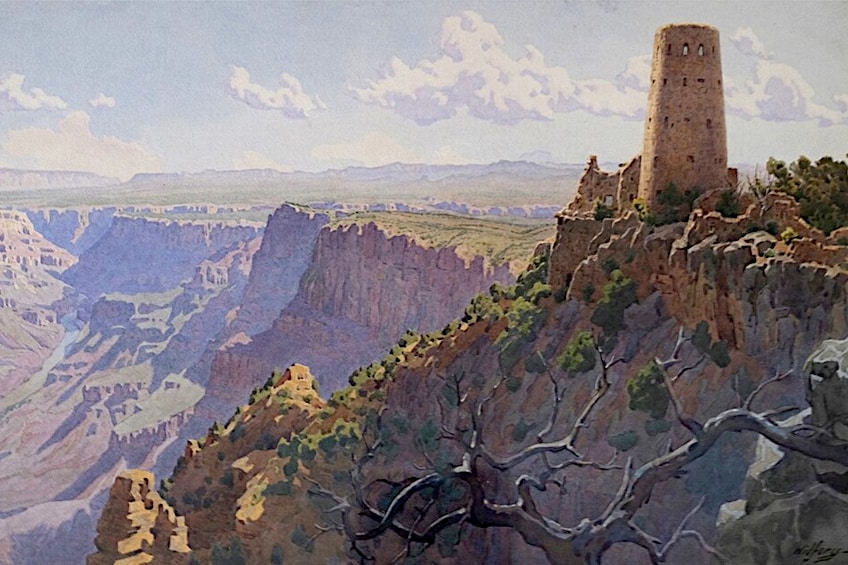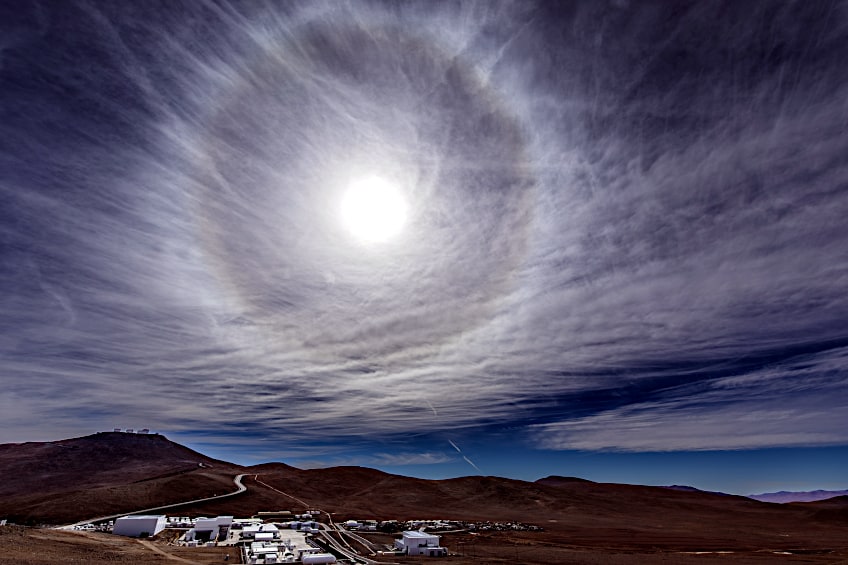What Is Atmospheric Perspective in Art? – Illusions of Depth
What is atmospheric perspective in art and are there atmospheric perspective examples? Atmospheric perspective is also known as aerial perspective in art. Many people would like to learn what atmospheric perspective painting adds to art and how to effectively use it. In this article, we will learn more about atmospheric or aerial perspective in art.
Contents
What Is Atmospheric Perspective in Art?
The impact of the atmosphere on the perception of objects when viewed from a distance is referred to as the atmospheric perspective. Things in the distance are less visible, and their color varies in saturation, value, and hue. Emphasizing these effects in your artwork will help you as an artist to heighten the atmosphere and feeling in your work. This increases the sense of distance and depth while also contributing to the mood and emotion of the environment. This atmosphere and sensation is an important aspect of the visual poetry of landscape painting.
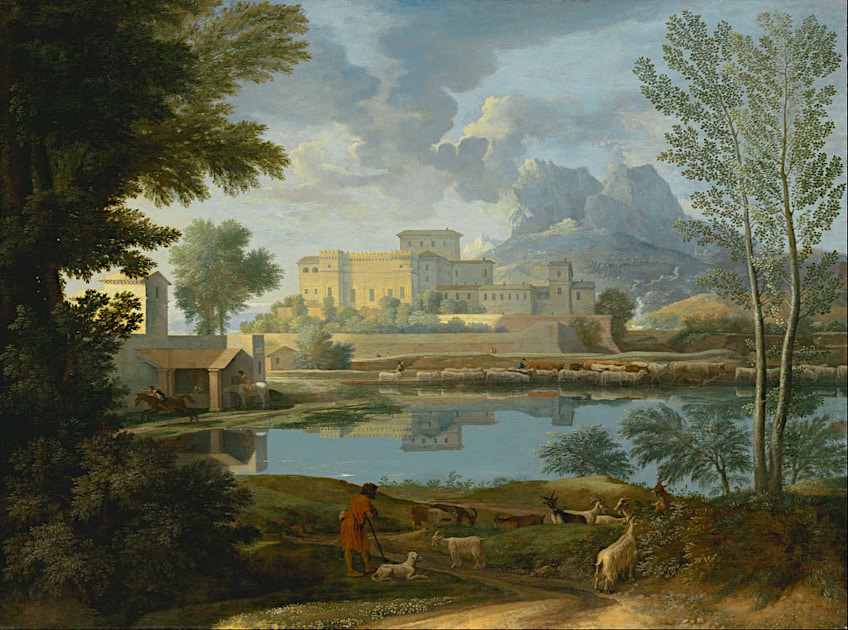
The Difference Between Linear Perspective Painting and Atmospheric Perspective
An artist can utilize two forms of perspective to create a sense of distance and proximity in an artwork: linear perspective and atmospheric perspective. The color of everything we perceive is affected by the atmosphere, which is referred to as atmospheric perspective. Linear perspective, on the other hand, describes how distance influences the form of objects, making them look smaller as they retract into the distance.
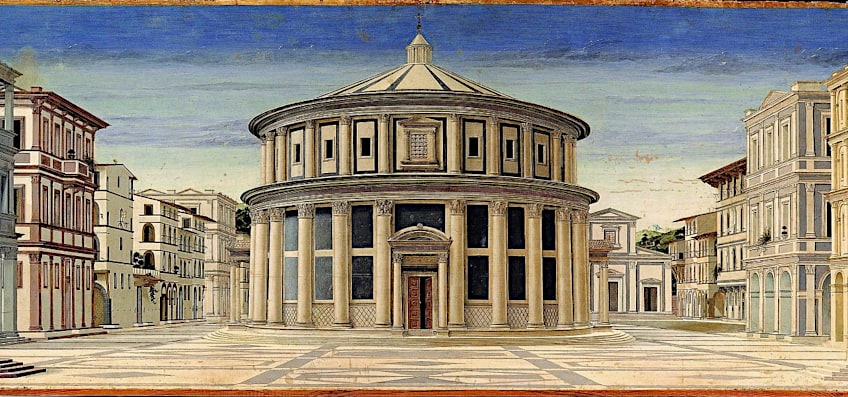
The Effects of Distance in Atmospheric Perspective Painting
The effect of atmospheric perspective, also known as aerial perspective in art, occurs when distant objects take on the hues of environmental haze. There are several ways the perception of distance can be created in an artwork. Here are some of the most fundamental observations regarding atmospheric perspective painting.
The saturation of objects reduces with distance. The colors of distant objects merge with and take on some of the hues of the atmosphere. As a result, they lose their unique color saturation and take on the saturation of the surrounding environment. If you operate in grayscale, the more distant items progressively acquire the value of the atmosphere as they move further away.
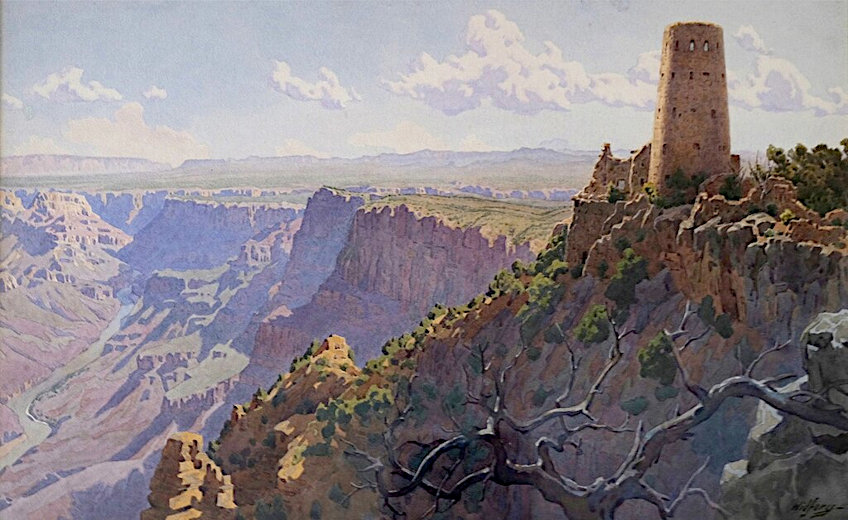
With increasing distance, the contrast lessens. Reduced contrast and saturation explain why fine details for distant objects are more difficult to see even using binoculars. Low contrast denotes a lack of distinction between the darkest and brightest parts. Low contrast does not imply blurriness!

The brightness grows with distance. Have you ever noticed how in many film clips, what’s closest to the camera is frequently darker than what’s further away? Try to spot it the next chance you get to watch a film. Film directors would frequently “smoke a set” using dry ice and then back-light the smoke to generate an atmospheric impression, even in outdoor settings such as rainforests where a lot of smoke is required!
Even at a distance, edges retain their sharpness. This rule is subject to two exceptions.
The first exception is if you want to intentionally blur the backdrop to produce an out-of-focus impression. Another exception is the heat-induced shimmer effect, such as in a desert mirage, while gazing through aircraft exhausts, and reflecting above the scorching tarmac. Variations in air gas density serve as a lens between the spectator and the item, causing this effect.

The distance at which things take on the hue and value of the atmosphere diminishes as the aerial perspective effect develops (e.g., severe fog, pollutants). In other words, when the influence of air haze grows, nearby things become more affected.
Strong lighting may reduce atmospheric perspective. If anything in the distance receives more illumination, such as the sun illuminating something via a break in the clouds, that lit item will regain more of its previous saturation and contrast when compared to unlit things at a comparable distance.
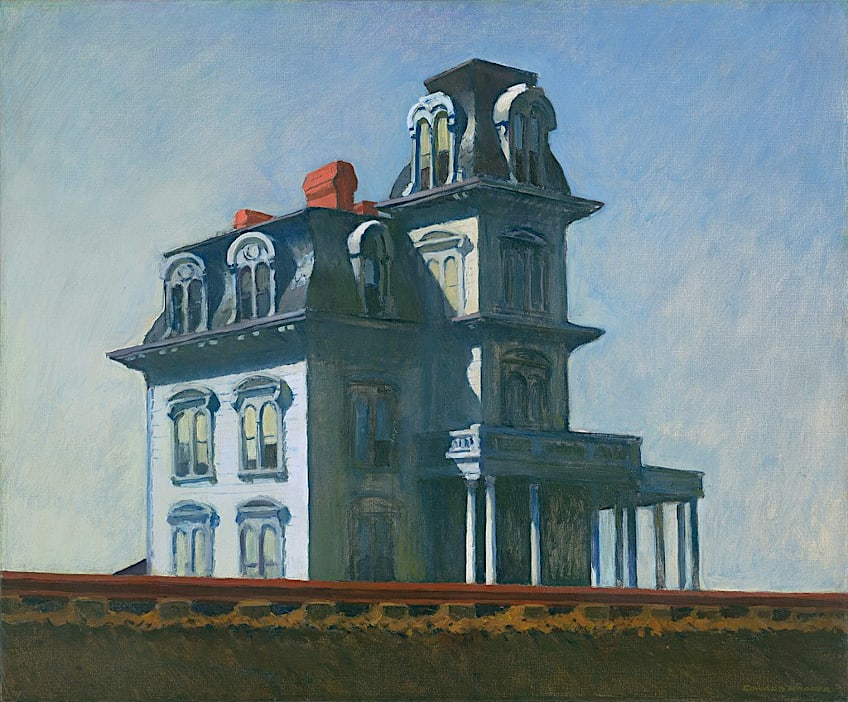
The Benefits of Using Aerial Perspective in Art
There are several advantages to atmospheric perspective paintings, including the ability for artists to save time. Aerial perspective reduces contrast and saturation with distance, and hence detail decreases with distance. Painters can use this to their advantage by painting distant background objects in less detail, which is significantly faster than painting everything in full. This approach is useful for objects that are relatively far away or in the background, such as trees, woods, buildings, mountains, and cities. In the distance, shadows and clues of detail are frequently sufficient to convey your piece’s theme, plot, and drama. Concentrate on detail where it is required and reduce where it is not. Less really is more.

It has the ability to generate and enhance the atmosphere, whether it be a frightening swamp, a secret hilltop fortress, or majestic views. You may adjust the tone of your picture, which can enable you to tell a tale. When certain details aren’t entirely clear and visible particularly in the distance when contrast is low, viewers are encouraged to actively participate with the image by filling in the gaps in their imagination. Aerial perspective causes nearby items to appear darker in tone than ones further away. As a result, works are simpler to comprehend.
Aerial perspective distinguishes foreground and background features in an image, resulting in a dramatic layering effect. The amount and hue of the atmospheric perspective effect provide observers with information about the image’s environmental circumstances and time of day. Use aerial perspective as a design technique to draw the audience’s eye to the focal point of the picture. By lowering saturation and contrast, non-focal areas can be pushed further back into the distance.

Factors Which Impact Aerial Perspective in Art
When compared to smog-free settings, smoggy industrial centers contain more dust, soot, and other sun-scattering particles in the air, resulting in harsher atmospheric perspective effects. When there is air pollution, the atmospheric perspective effect is strongest near the ground, resembling a golden ground fog that rises hundreds of meters above the Earth’s surface. At dusk or dawn, aerial perspective is at its most magnificent. When the sun is low in the sky, it emits a rainbow of rich and diverse hues into the atmosphere, including reds, oranges, yellows, and purples.
Atmospheric refraction of light by ice particles in the sky; Stock image
Distant things take on these hues, making the scene more intriguing than it would be during other times of the day. Other lighting effects, such as light rays, may be used. Because water particles hanging in the air scatter light, fog, dampness, and mist all intensify the aerial perspective impression. Cold misty highlands and hot, steamy rainforests are typical atmospheric perspective examples.
Storms and rain limit visibility, although their influence on aerial perspective may be less consistent and more unpredictable than when conditions are calm. The visibility of a broad sweeping panorama may change across the landscape. For example, certain areas of the image may have heavy rain and a dramatic atmospheric perspective effect, while others may have bright sun. Areas with a lot of sand or dirt on the ground might acquire a lot of atmospheric perspective during and after high winds gather up the particles and blow them into the sky. Distant things would be colored by the dust.
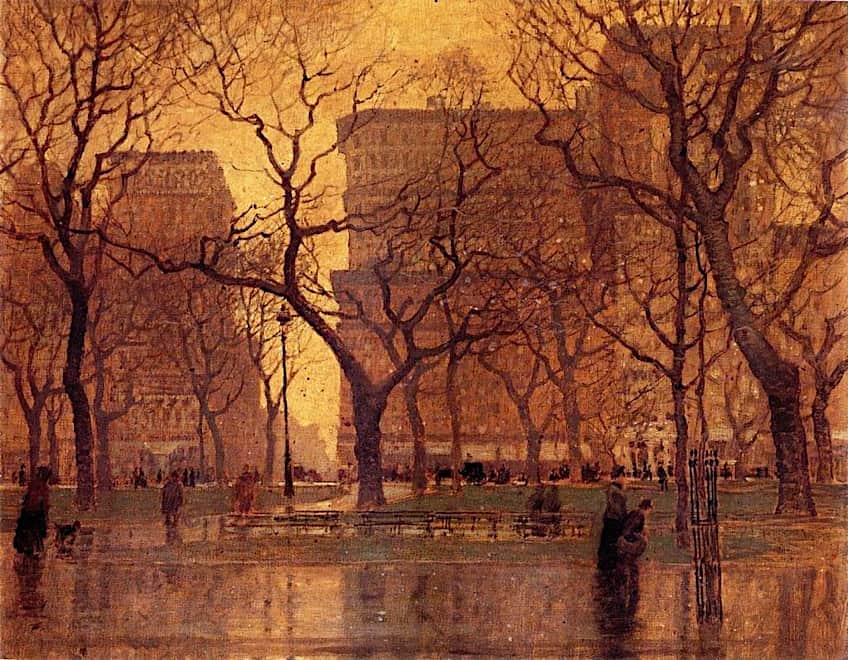
In art, atmospheric perspective produces the appearance of space in a 2D piece. Atmospheric perspective accentuates spatial intervals or the distance between things; as things recede into the horizon, they are becoming less distinct, and softer in contrast. Objects in the front, on the other hand, are articulated with fine features and a great contrast to help them stand out in the composition.
Frequently Asked Questions
What Is Atmospheric Perspective in Art?
Aerial perspective, also known as atmospheric perspective, is a method used in art to create a sense of depth by presenting distant things as lighter, less detailed, and frequently less contrasted than nearby objects. Leonardo da Vinci used this approach in painting to depict what he saw in nature, which was derived from his interest in optics. A painter can use this approach to represent the influence the atmosphere has on an object when viewed from a distance. The contrast between an object and its backdrop reduces as the distance between the object and the observer increases, as does the contrast of any features inside the object. The colors of the item become less saturated and move toward the color of the atmosphere, which is blue when sunny but can change to various colors under specific situations.
What Are the Benefits of Using the Atmospheric Painting Technique?
Aerial perspective causes detail to diminish with distance due to a loss in contrast and saturation. In order to paint everything quickly, artists might take advantage of this by portraying faraway background objects in very little detail. An aerial perspective creates a clear distinction between foreground and background elements in an image, creating a striking layering effect.
Are There Atmospheric Perspective Examples of Artists Who Use the Technique?
Many masters, as well as contemporary artists, have utilized aerial perspective in art. This includes artists such as Caspar David Friedrich, George Tooker, Norman Ackroyd, Leonardo da Vinci and many more. By applying this effect effectively, they can add incredible depth to their works.
When Was the First Use of Aerial Perspective in Art?
The atmospheric perspective was employed in Pompeian Second Style frescoes, which date back to 30 BCE and are one of the Pompeian Styles. Polymaths, such as Leonardo da Vinci and Leon Battista Alberti, wrote descriptions of the impacts of atmospheric perspective with varying levels of accuracy. In several of his works, Alberti utilized aerial perspective, developing a technique for precisely painting the effect that was adopted by his successors, the Leonardeschi. Art historians point out that it is missing in works by several painters of the same period, like Raphael, despite the fact that he used sfumato.
Jordan Anthony is a Cape Town-based film photographer, curator, and arts writer. She holds a Bachelor of Art in Fine Arts from the University of the Witwatersrand, Johannesburg, where she explored themes like healing, identity, dreams, and intuitive creation in her Contemporary art practice. Jordan has collaborated with various local art institutions, including the KZNSA Gallery in Durban, the Turbine Art Fair, and the Wits Art Museum. Her photography focuses on abstract color manipulations, portraiture, candid shots, and urban landscapes. She’s intrigued by philosophy, memory, and esotericism, drawing inspiration from Surrealism, Fluxus, and ancient civilizations, as well as childhood influences and found objects. Jordan is working for artfilemagazine since 2022 and writes blog posts about art history and photography.
Learn more about Jordan Anthony and about us.
Cite this Article
Jordan, Anthony, “What Is Atmospheric Perspective in Art? – Illusions of Depth.” artfilemagazine – Your Online Art Source. April 11, 2023. URL: https://artfilemagazine.com/what-is-atmospheric-perspective-in-art/
Anthony, J. (2023, 11 April). What Is Atmospheric Perspective in Art? – Illusions of Depth. artfilemagazine – Your Online Art Source. https://artfilemagazine.com/what-is-atmospheric-perspective-in-art/
Anthony, Jordan. “What Is Atmospheric Perspective in Art? – Illusions of Depth.” artfilemagazine – Your Online Art Source, April 11, 2023. https://artfilemagazine.com/what-is-atmospheric-perspective-in-art/.


